Incarville's slice quickly loses its appeal, because its buds will be covered almost in front of her eyes. But in the garden, it will take an honorable place on a simple flowerbed, in Alpinaria, Rabata, or decorate Alley near the house. She will be long days to delight with their bloom, while not exposing special requirements for growing conditions. What is so attracting the attention of this flower, and how does the inkviller in landing and subsequent care? Consider all the basics of agricultural engineering for a delicate beauty.
Content |
Incarville, Beauty Flower in detail
Inharvillea or, as they are often called, garden gloxinia brought Asian motifs to our gardens. After all, her homeland is Tibet and North Asia. This, at first glance, a careless plant to the Bignonia family and with sufficient care confidently grows in medium latitudes as a perennial.
The genus inkvillei is not a few and includes 14 species. Among them, they can meet herbal cultures and larger semi-stabilics. Here is what else you can learn about Inharvillery, referring to scientific sources:
- Inkarvillei's stalks are rivally branched, less often - single. The surface of the stems can be smooth or fluffy. On average, the growth of the flower depending on the variety ranges between 30 and 200 cm.
- At the base of the plant, a durable dark green rosette of the leaves is formed. The form of foliage can be very different. One species leaves the heart-shaped or slightly rounded, developed on a long root. Other specimens are petty, filament, seemingly resembling the greens of fern.
- Incarvillea is a tuber culture. The tubers are a bit elongated, with small root branches, externally very resembling carrots. Some species have a riveted rhizome.
- Incarvillea is a thermal-loving flower, but when building shelter is not bad in the garden even in regions with severe weather conditions. Withstands Culture Frost to -15⁰.
- Tubular flowers, very gentle and easily damaged even from touching. The inflorescence consists of a height of fused together the petals, slightly turned outwardly. Color diameter up to 6 cm, color - gentle white, amaranth pink, pinkish-purple, yellow, blue-purple, purple, light red.
- Inflorescences form a group of 4-10 flowers and beautifully bloom on the blurred flowers.
- Blossom continues from June to early September. On average, the inkvillea flows 45 days, which depends on weather conditions.
- Inkarvillei fruits - seeds with a darous grayish coating. Sports in elongated seed boxes. Their collection is carried out at the end of August.
Amazing grade Incarvillei
In moderate latitudes, gardeners successfully planted the following grades of Inharvillee:
- Inharvillea is done - the Chinese variety, it looks very rich in flowering. Its buds after breaking reach 6 cm in diameter. The variety is large enough, some copies are pulled up to 120 cm in height. Needs shelter. The colors of flowers is also a solid - gentle pink, light crimson, magenta ...
- Inkvillea Mayer - stands out of luxurious red-pink buds. The whine of this variety is inside yellow with the asymmetric placement of white specks. The growth of the Mayry can reach 70 cm, the inflorescences are large, the fragrance is absent. The variety is inherent in high winter resistance to -29⁰.
- Inharvillea Chinese "White Swan" is an unsurpassed creation of breeders. Blossom comes 2.5 months after sowing. Creamy shade inflorescences, they quickly replace each other, due to the formation of young shoots.
- Incarvillee is dense - perfectly winter even without shelter. Origin - Tibet, Western China. The variety is low, with medium sized infloresions, color - gently purple with a pale yellow asterisk in the middle. Leaf of rounded shape, light green color. It has a large-scale variety - inkvillya white. Blooms early - in May, the buds of 8 cm in the diameter.
- Incarvillea Olga - Guest from Pimiro Alaya. This is a perennial height of up to 145 cm. The leaves are opposite, peristracted. Tender flower, red-scarlet, very small up to 2 cm in diameter.
- Incarvillea Pink is a mid-graduated bread with bright pink flowers. They are combined into a major inflorescence on the elevated over the foliage of the flower. Complete winter resistant.
Inharvillery landing and reproduction
Incarvilia easily breeds. To do this, you can use both seeds and any parts of the plant - tubers, leaves, cuttings. Difficulties practically do not even occur in inexperienced gardeners.
Incarville, growing from seeds
This is the most acceptable way of reproduction with the ability to create new colors. At the end of the summer, seeds are collected, dried and stored. Two weeks before the arrival of March, the seeds give up a two-week stratification in cold water.
Then they are sowing in shallow tanks with neutral fertile soil, pre-moistened. The sowing material is evenly distributed over the surface, slightly deepening each seed of 1 cm, sprinkled with soil.
If the room temperature is not lowered below + 18⁰, shoots are reluctant to turn around 7 days. If the temperature is at least a degree below, you will have to wait another week before the sprouts appear. Care is carried out by the usual - watering, fertilizer (if the soil is not very fertile).
Seeds in peat pills germinate well. In the scalded cups, the tablets are discharged and then plug one seed on 10 mm. Then on top they put on the second cup, forming the guy, and kept in the warm room.
After the appearance of the two leaves, seedlings inkarvillei dive into individual pots. In the first days of June peresazhivatsya seedlings to the flower bed. In this observed distance between plants. It must be from 25 to 50 cm, whichever grade.
Root neck inkarvillei need to deepen not more than 3 cm. After planting, the plant is well watered and pritenyayut the entire adjustment period. If the soil in the area of \u200b\u200binfertility, before planting seedlings in the prepared place dug a hole in the 40-45 cm depth and add compost.
The only drawback inkarvillei is that it does not tolerate the pick, and even more difficult to take root in the flowerbed. Therefore, the best option - planting in open ground. This is done when the temperature is kept at + 20⁰S. Seeds are lowered into the groove depth of 1 cm. Shoots are seen within a week.
Propagation by cuttings inkarvillei
A well-formed adult bush stalks are cut apical angle 40-45⁰S. Length cuttings -. 4-5 cm Then they are immersed in a solution with a drug that stimulates the growth of roots, such as "Kornevin". Thereafter, the cuttings were placed in pots with peat and create greenhouse conditions for rooting. Daily greenhouse ajar for air flow, and the soil is moistened.
Inkarvillei reproduction by dividing the bush
rhizomes of plants in early spring dig, sharp spade cut small delenki to present healthy germ. Then fit a young specimens, dropwise with root neck to 3-3.5 cm.
Incarvillea, planting and care in the open field
This flower nepriveredliv and very responsive. For him, it is not necessary to prepare an unusual soil or look for some specific place for planting. All that he needs - is an easy-drained soil and adequate watering. Very loyal and incarvillea to the site. It grows equally well on both sunny and in shady spot.
Organization of watering and care of the soil inkarvillei
All kinds of plants prefer moderate moisture. They quickly die from over-watering or after fossilization of land in the root zone. Therefore, irrigation is carried out on the need, when the upper layer of soil is dry. Moisturizing should be done in the morning or evening when the sun will not burn inkarvilleyu. After wetting the soil once it is desirable to loosen and weeding.
fertilizing inkarvillei
Approach to fertilizer may be different, that depends on the soil at the site. If the ground is fertile, you can do without feeding inkarvillei. If the plant is planted in a poor substrate, preferably several times a year to feed its mineral complexes. Also suitable weak mullein solution. But we should remember that an excess of organic matter significantly reduces winterhardiness plants. Fertilize unscheduled need for the transplant or planting flower delenok.
transplanting inkarvillei
The plant does not like to stay in one place. To abundant flowering do not cease from year to year, inkarvilleyu transplanted every third year. The division of tubers and planting is best to start in June or in August.
Incarvillea care after flowering and wintering
Most varieties inkarvillei need of hiding for the winter. Their root system can not tolerate sudden temperature jumps and cold winters without snow. If the flower is grown as a perennial crop, it is necessary to prepare the mulch and cover it inkarvilleyu. Peat mixed with humus and make the flooring over tubers height of about 7 cm.
It is undesirable to cover the bushes a lot of fallen leaves. Under such flooring tubers can vypret and die. Young bushes in the winter is better to cover the glass jars or plastic bottles. This is more reliable color protection from the cold and thaw. Spring mulch immediately removed to give the roots a sufficient flow of oxygen.
Pests and diseases inkarvillei
Roots inkarvillei particularly often subject to decay. Different types of rot quickly activated in a very humid environment, fully hit tubers and restore the flower is extremely difficult. Therefore, at the first sign of wilting, the plant must be treated with fungicide. You can use any means - rather, fundazol and others.
The above-ground part of the plant affected spider mites, at least - mealybug. Pests drink the juice from the leaves and the plant loses its form. Inkarvilleyu cure can be insecticide - Akktelikom, Akhtar.
Incarvillea, photos and role in landscape design
Incarvillea - universal inhabitant of the garden, which will not be lost in the group beds, and will look great in a single planting. The plant looks perfectly on the stony rock garden or just in pots around the house. Therefore, no matter where you put inkarvilleyu, it will be everywhere to the site.

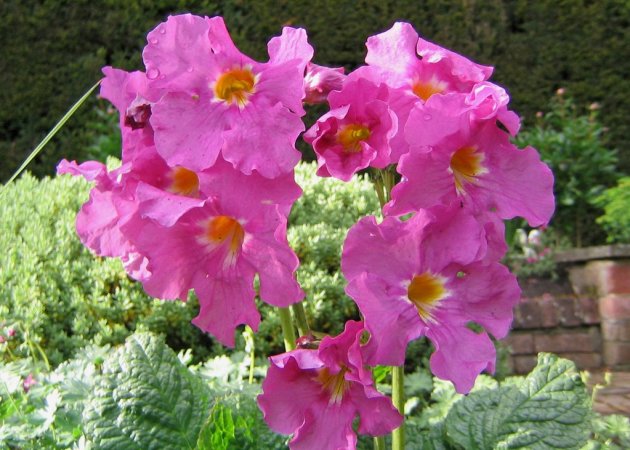

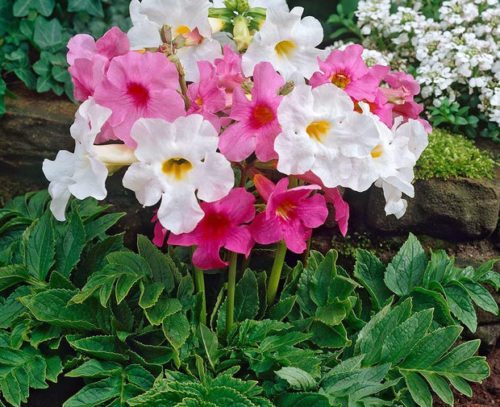
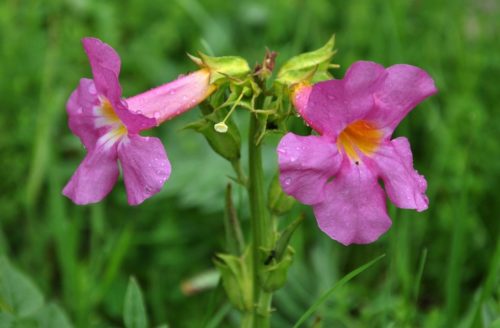
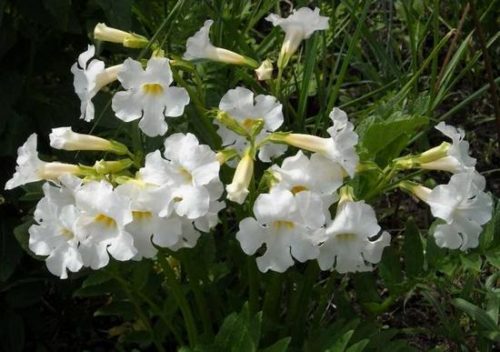
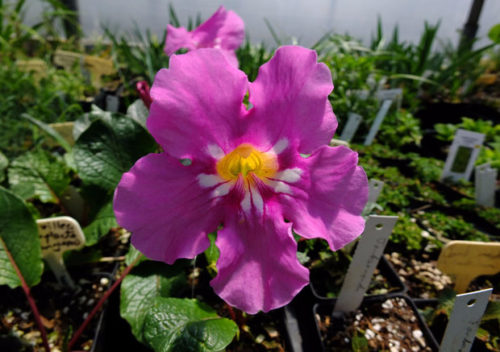
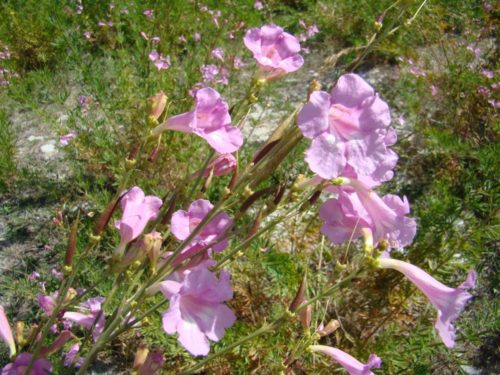
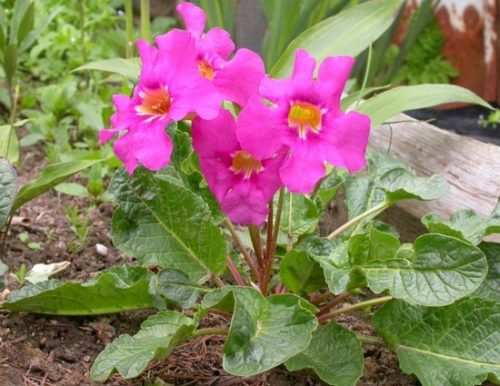
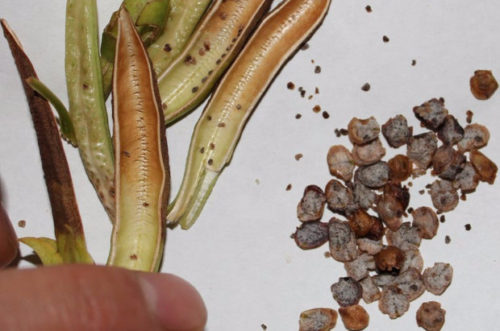
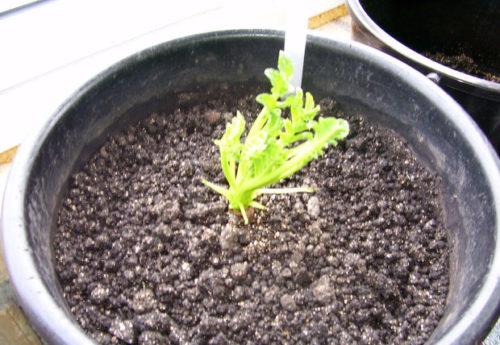
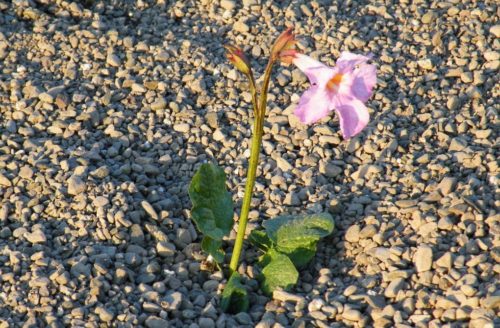

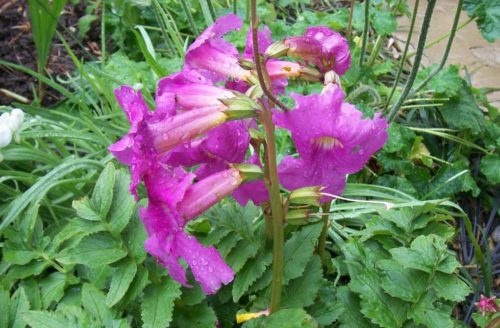
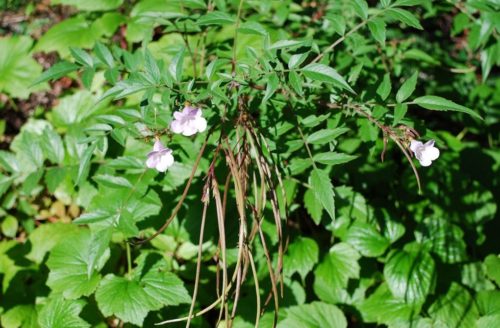

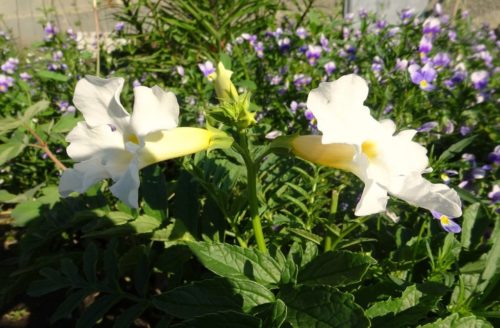

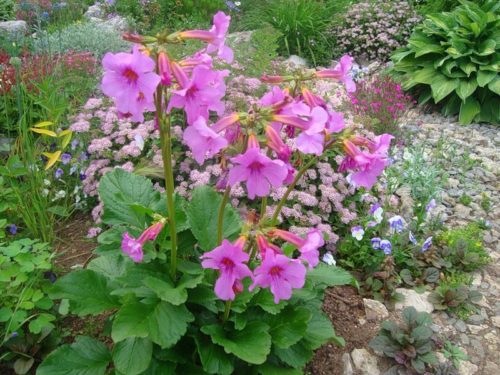
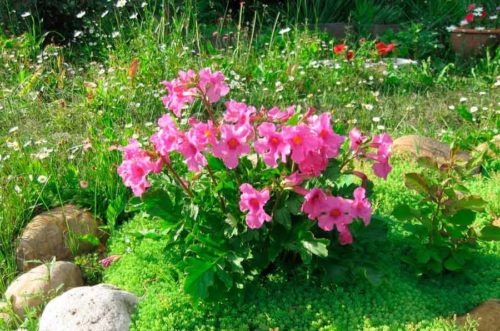
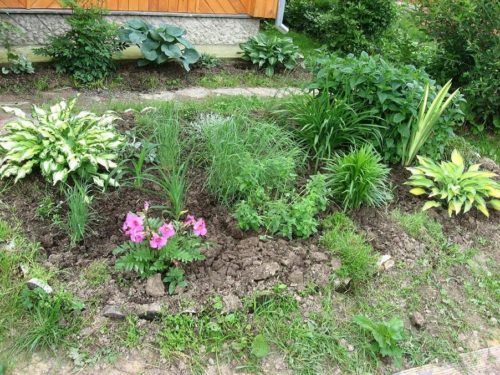
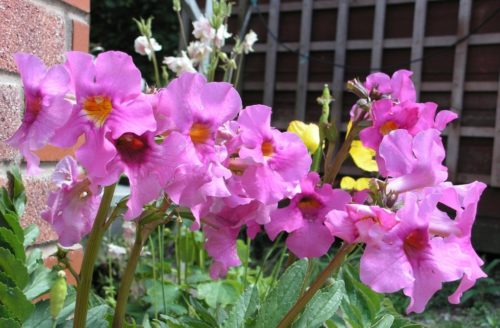
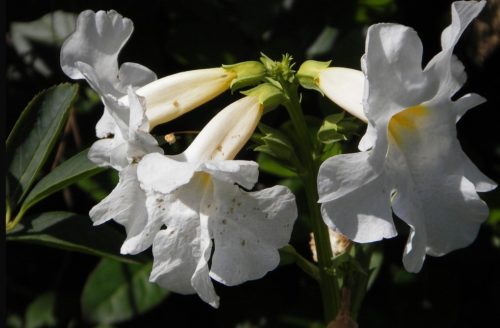
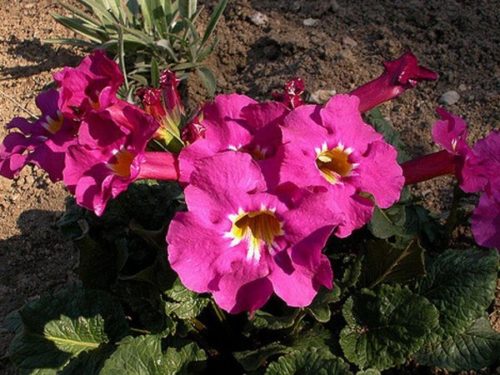
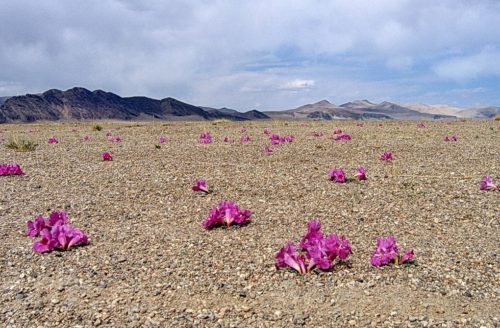












 Start a discussion ...
Start a discussion ...